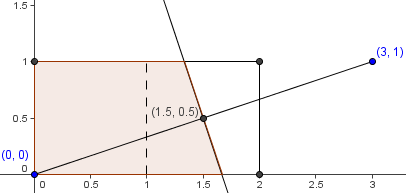Difference between revisions of "2002 AMC 12B Problems/Problem 18"
(→Solution 2) |
(→Solution 2) |
||
| Line 23: | Line 23: | ||
draw((-1,0)--(-2,0)); | draw((-1,0)--(-2,0)); | ||
draw((-1,0)--(-1,-1)); | draw((-1,0)--(-1,-1)); | ||
| + | draw((3,0)--(3,1)); | ||
label("(0,0)",(-1.5,-0.5)); | label("(0,0)",(-1.5,-0.5)); | ||
| − | label("( | + | label("(3,1)",(5.5,2)); |
| − | |||
| − | |||
| − | |||
</asy></center> | </asy></center> | ||
Revision as of 15:53, 2 July 2019
Problem
A point ![]() is randomly selected from the rectangular region with vertices
is randomly selected from the rectangular region with vertices ![]() . What is the probability that
. What is the probability that ![]() is closer to the origin than it is to the point
is closer to the origin than it is to the point ![]() ?
?
![]()
Solution
Solution 1
The region containing the points closer to ![]() than to
than to ![]() is bounded by the perpendicular bisector of the segment with endpoints
is bounded by the perpendicular bisector of the segment with endpoints ![]() . The perpendicular bisector passes through midpoint of
. The perpendicular bisector passes through midpoint of ![]() , which is
, which is ![]() , the center of the unit square with coordinates
, the center of the unit square with coordinates ![]() . Thus, it cuts the unit square into two equal halves of area
. Thus, it cuts the unit square into two equal halves of area ![]() . The total area of the rectangle is
. The total area of the rectangle is ![]() , so the area closer to the origin than to
, so the area closer to the origin than to ![]() and in the rectangle is
and in the rectangle is ![]() . The probability is
. The probability is ![]() .
.
Solution 2
![[asy] unitsize(36); draw((-1,0)--(5,0)--(5,2)--(-1,2)--cycle); draw((-1,2)--(-1,3.5)); draw((5,0)--(6.5,0)); draw((-1,0)--(-2,0)); draw((-1,0)--(-1,-1)); draw((3,0)--(3,1)); label("(0,0)",(-1.5,-0.5)); label("(3,1)",(5.5,2)); [/asy]](http://latex.artofproblemsolving.com/c/a/3/ca3ce9749dd4e3ea17e5983f7e7564e075eee386.png)
Assume that a point ![]() is randomly chosen inside the rectangle with vertices
is randomly chosen inside the rectangle with vertices ![]() ,
, ![]() ,
, ![]() ,
, ![]() .
.
In this case, the probability that ![]() is closer to the origin than to point
is closer to the origin than to point ![]() is
is ![]() .
.
If ![]() is chosen within the square with vertices
is chosen within the square with vertices
See also
| 2002 AMC 12B (Problems • Answer Key • Resources) | |
| Preceded by Problem 17 |
Followed by Problem 19 |
| 1 • 2 • 3 • 4 • 5 • 6 • 7 • 8 • 9 • 10 • 11 • 12 • 13 • 14 • 15 • 16 • 17 • 18 • 19 • 20 • 21 • 22 • 23 • 24 • 25 | |
| All AMC 12 Problems and Solutions | |
The problems on this page are copyrighted by the Mathematical Association of America's American Mathematics Competitions. 










